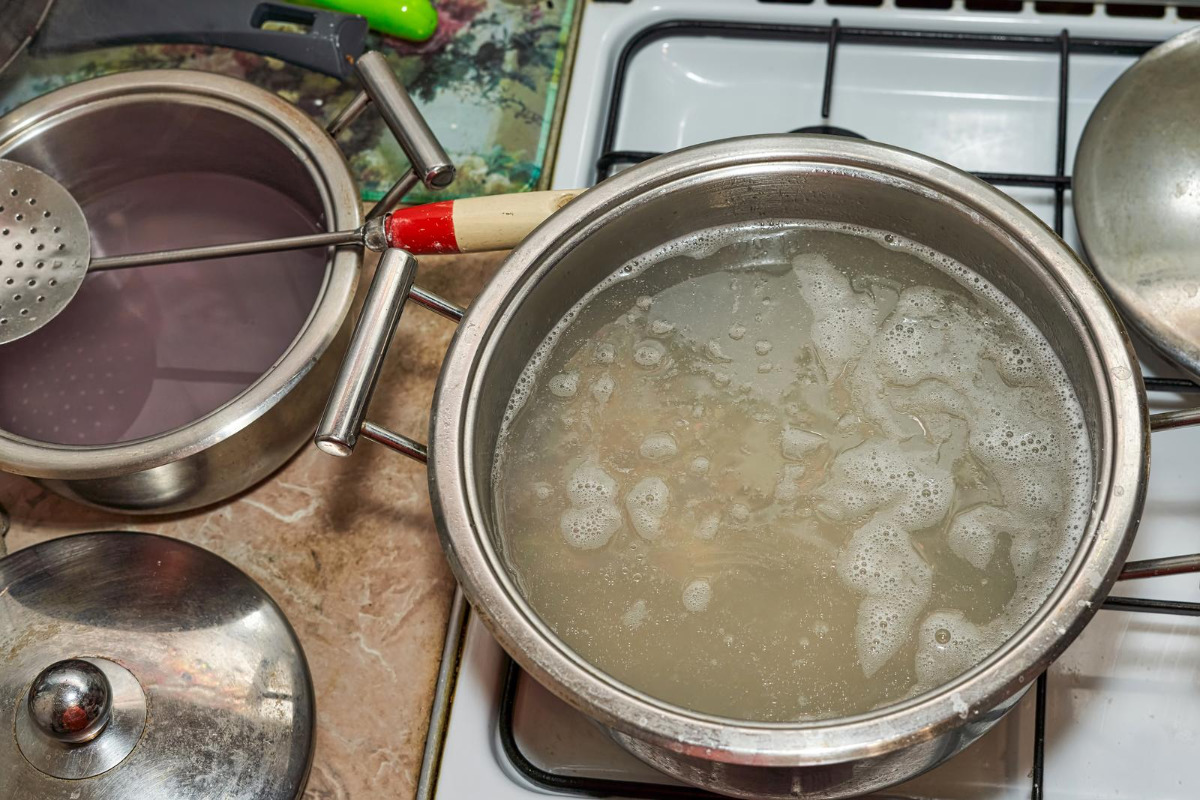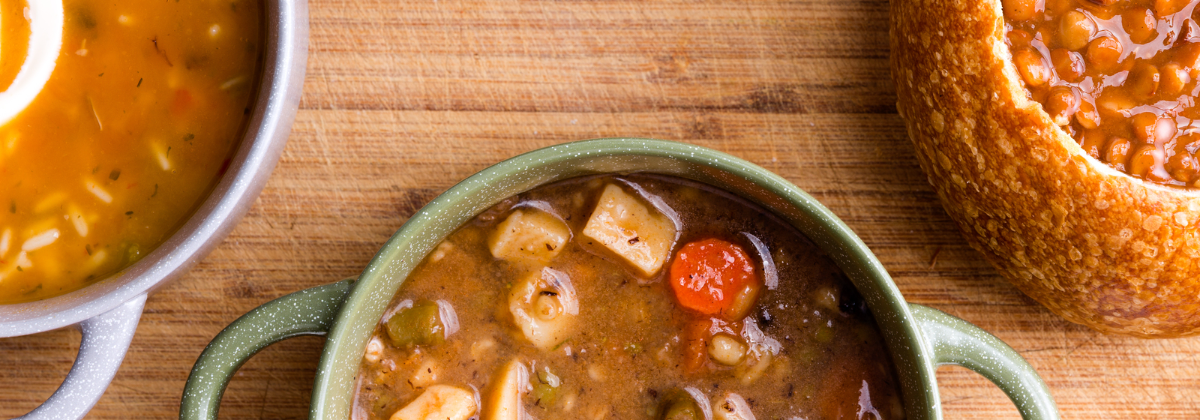The key to any great soup lies within its consistency – not too thick, not too thin. A perfect soup is centered around flavor, experience, and a delicious soup side dish. But a runny consistency happens even with the best of chefs. Much like knowing how to make soup less salty, you need to know how to thicken soup. Well, I’ve got several of the best ways.
You can thicken soup using cornstarch, roux, vegetable purees, egg yolk, and reduction. But there are a couple more tricks for thickening soup. So, let’s dive in!

Contents
📌 What Causes Soup to be Runny?
Excessive Water/Broth: If you add too much water or broth, the soup’s base becomes too thin.
Insufficient Simmering: Without enough time simmering, water doesn’t evaporate, which thickens the soup naturally.
Low Ratio of Thickeners: Soups usually need a thickening agent like flour, cornstarch, or potatoes, and if you use too little, the consistency won’t be right.
High Water Content in Vegetables: Some vegetables, such as tomatoes or zucchini, release water as they cook, contributing to a thinner soup.
Undercooked Grains or Legumes: When you use rice, pasta, or beans, they have to be cooked long enough to release starches that naturally thicken the broth.
Rapid Cooking: Slow cooking allows for better melding of flavors and reduction, while rapid cooking might not give enough time for the soup to thicken.

💡 Ways to Thicken Soup
Cornstarch or Arrowroot Slurry
A quick and simple solution for thickening soup. This method is particularly useful when you want a clear or glossy finish in the soup, as cornstarch and arrowroot have the capacity to create a smooth texture without clouding the liquid. Cornstarch or arrowroot slurry is also a preferred option for those who may have dietary restrictions, as it is gluten-free compared to alternatives like flour-based roux.
It involves creating a slurry with one part cornstarch or arrowroot and two parts cold water, smoothly incorporating it into the simmering soup while stirring constantly to prevent lumps.
Roux-Based Thickening
When aiming for a richer flavor and creamy texture in the soup, you can rely on a roux by cooking equal parts flour and fat until they form a paste. Just add the roux in small increments while continually whisking.
The flour in the roux serves as a thickening agent, absorbing and swelling with the liquid in the soup, resulting in a luscious, velvety texture. The fat component, often butter, contributes to the overall richness and enhances the flavor profile of the soup.
Reduction Method
Simmering the soup over low heat will also naturally thicken it through the reduction method. The basis of this method is the evaporation of water and solidification of the ingredients in the soup. This process allows excess water to evaporate and other ingredients that are present in the soup to thicken. In turn, leaving a thicker consistency.
This process also intensifies flavors and is suitable for broths and stocks. However, vigilance is necessary to prevent burning or overly concentrated flavors during the reduction process.
Pureed Vegetables
For a health-conscious approach to soup thickening, try pureed vegetables. Just blend them until smooth and mix into the soup. Vegetables like cauliflower, carrots, or potatoes, when blended until smooth, create a nutrient-rich base, adding thickness to the soup.
The pureed vegetables act as a natural thickening agent, creating a velvety and balanced texture in the soup. Beyond their thickening properties, these purees introduce a spectrum of colors, flavors, and essential nutrients, enhancing both the visual appeal and nutritional content of the dish.
Egg Yolks
Egg yolks contribute to soup thickening through their emulsifying properties. When whisked and tempered with a bit of hot soup before being reintroduced into the pot, they emulsify. The proteins in egg yolks act as binding agents, assisting in thickening the soup by creating a cohesive structure.
The emulsification process with egg yolks also lends a rich and smooth consistency, enhancing the overall mouthfeel. Beyond their thickening role, egg yolks bring a balance of flavors and textures to soups.
Cheese or Cream
Incorporating grated cheese or heavy cream into soup provides a route for achieving a thicker, richer texture and a luxurious feel, enhancing the overall body of the soup. The emulsifiers in cheese help blend fats and liquids, contributing to a smooth consistency.
Cream’s proteins act as binding agents, stabilizing the soup and preventing separation. The choice between the two depends on the desired flavor and texture of the soup. But both act as similar great thickeners.
Bread Crumbs
For a quick thickening method, particularly in rustic soups, sprinkle in dried bread crumbs to absorb excess liquid and achieve the desired thickness. By carefully selecting the most appropriate method based on the recipe and desired outcome, each technique imparts distinctive qualities and benefits to the soup.
🥘 Adjusting Soup Thickness
Correcting Over-Thickened Soup
If you find your soup has become too thick, there’s an easy fix. Gradually add small amounts of a liquid such as broth, water, or milk, stirring constantly until the desired consistency is reached. It’s vital to do this slowly and taste as you go to ensure you don’t dilute the flavors too much.
Balancing Flavors and Textures
Balancing flavors and textures in your soup is key to a satisfying dish. If the soup’s thickness has muted the flavors, introduce a tangy element like lemon juice or vinegar to brighten it up. Enhance the texture of creamy soups with something like croutons for a contrasting crunch. Always aim for a harmony of tastes and sensations in every spoonful.
🧐 Frequently Asked Questions
Yes, soup generally tends to thicken as it cools because the reduction in temperature allows the starches and proteins within the soup to contract and absorb less liquid.
The healthiest way to thicken soup is by using puréed cooked vegetables, such as potatoes or beans, which add fiber and nutrients without refined starches or additional fats.
It depends on your nutritional preferences and the desired consistency of the soup. Flour can provide a more opaque, heartier texture, while cornstarch offers a glossier appearance and a silkier mouthfeel with less required quantity.
Milk can effectively thicken a soup when combined with a roux, which is a mixture of equal parts butter and flour cooked together before adding the milk. This prevents clumping and creates a creamy consistency.
